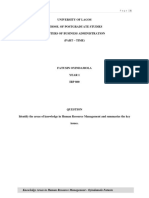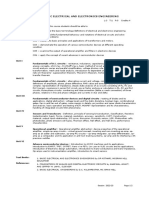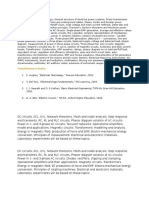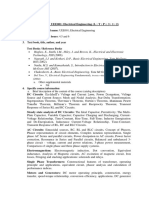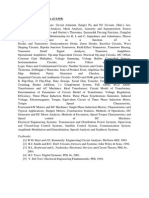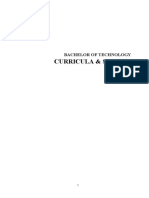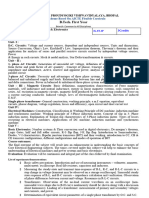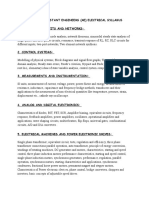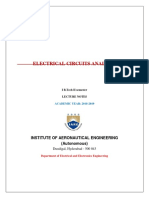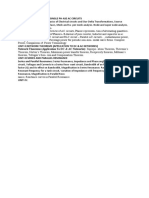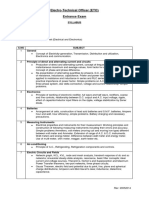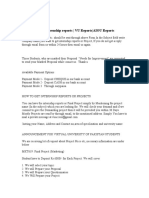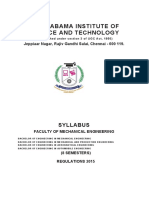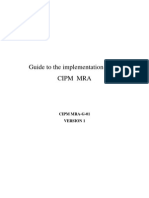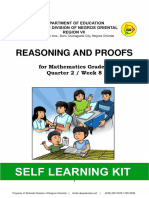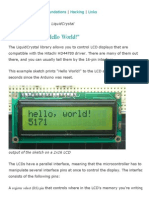Syllabus - EE1100 (April - June 2021)
Syllabus - EE1100 (April - June 2021)
Uploaded by
Phalgun Mukesh Vyas ch19b076Copyright:
Available Formats
Syllabus - EE1100 (April - June 2021)
Syllabus - EE1100 (April - June 2021)
Uploaded by
Phalgun Mukesh Vyas ch19b076Original Title
Copyright
Available Formats
Share this document
Did you find this document useful?
Is this content inappropriate?
Copyright:
Available Formats
Syllabus - EE1100 (April - June 2021)
Syllabus - EE1100 (April - June 2021)
Uploaded by
Phalgun Mukesh Vyas ch19b076Copyright:
Available Formats
EE 1100 Basic Electrical Engineering – Syllabus
April - June 2021
Topics
1. Introduction, Course overview, Basics and definitions: Electric current and quantity of electricity,
potential difference and resistance, linear and non-linear devices, Ohm's law, conductors and
insulators, electrical power and energy.
2. Circuit laws and solving for unknowns: description & derivation of Kirchhoff’s laws, series and
parallel connections, analysis of circuits using Nodal analysis technique. Usage of the principle of
linearity and superposition to solve when multiple sources are present. Thevenin’s equivalent circuit
representation. Maximum power transfer in a circuit.
3. Dynamic circuit components L & C: derivation of the relationship between current and voltage in
capacitors(C) and inductors (L), power in L & C, combination of R & L , R & C, numerical & graphical
analysis of transients with DC sources, combination of R, L & C in circuits.
4. Single phase AC circuits: Introduction to AC signals and sources, description of AC signals using
magnitude, frequency and phase, distinguishing between peak, average and RMS values,
Single phase AC circuits: Differentiate between DC and steady state, calculation of power in AC
systems
5. Definition of power in AC circuits, Differentiating between active, reactive and apparent power,
introduction to power factor, usage of phasors to represent, manipulate and calculate circuit
quantities like voltage, current, impedance and power
6. Derivation of properties of R, L and C with AC signals, introduction to Impedance(Z) and admittance
7. Single phase AC circuits : Application of circuit analysis techniques to AC systems, analysis of
frequency response of R, L and C, calculating transfer-function of a circuit, pole-zero plots, Analysis
of frequency-domain response of RLC circuits.
8. Poles and zeros (contd.), Bode plots of transfer functions, filters: low-pass, high-pass, band-pass
and band-reject.
9. Three-phase AC circuits: power in 3-phase circuits, star and delta connection.
10. Diodes, applications of diodes: Diode characteristics (ideal, semiconductor), voltage and current
relationship, diode circuits- rectifiers, peak and envelop detectors.
11. Operational amplifiers: Description of amplifiers as a black box and definition of gain, effect of
feedback on gain, operational amplifiers, sum and difference amplifiers, integrators, differentiators,
buffers.
12. Single phase transformer: principle of operation, equivalent circuit, equivalent circuit, parameters,
open circuit and short circuit tests, voltage regulation and efficiency.
13. Induction machine: principle of operation, equivalent circuit, no-load and blocked rotor test,
torque-slip characteristics, efficiency.
14. DC machines: general construction of DC machines and description of parts, DC generators and
motors, excitation configurations, uses of series, shunt or separately excited machines, speed and
torque, connection between the electrical and mechanical domain.
* Assignments will be graded
* Exams : Mid-sem and End-sem will be conducted
* Any changes will be communicated in class and via course Moodle
Books:
● Electrical Circuit Theory and Technology, John Bird, Elsevier, 2011 [Text book]
● Essentials of Electrical and Computer Engineering, Kerns & Irwin, Pearson, 2004
● Electrical Engineering Fundamentals, Vincent Del Toro, Prentice Hall, 2006.
● Electrical Engineering Concepts and Applications, Carlson and Gisser, Addison Wesley, 1990.
You might also like
- Three Knowledge Areas in Human Resource ManagementDocument14 pagesThree Knowledge Areas in Human Resource ManagementOyindamola Fatusin80% (5)
- Ab60F Automatic Transmission: DescriptionDocument2 pagesAb60F Automatic Transmission: Descriptionautomaticosbrasil0% (2)
- Moral, Social and Cultural Studies: Grade GradeDocument161 pagesMoral, Social and Cultural Studies: Grade Gradearadhya100% (1)
- Hospital PlanningDocument26 pagesHospital PlanningPoonam Tomar100% (4)
- Ece131 SyDocument2 pagesEce131 SySmita Rani SatapathyNo ratings yet
- Principles of Electrical Engineering (ECE) : Unit 1 DC CircuitsDocument2 pagesPrinciples of Electrical Engineering (ECE) : Unit 1 DC CircuitsPavan KumarNo ratings yet
- Lecture 0 - Introduction To The CourseDocument4 pagesLecture 0 - Introduction To The CourseTushar SharmaNo ratings yet
- Text/Reference BooksDocument5 pagesText/Reference BooksAnonymous DuNDBdNo ratings yet
- Syllabus KEE101TDocument1 pageSyllabus KEE101TDr. Abhishek MishraNo ratings yet
- Basic Electrical EngineeringDocument2 pagesBasic Electrical Engineeringnetcity143No ratings yet
- Name of Department:-Electrical EngineeringDocument2 pagesName of Department:-Electrical EngineeringAnonymous HyOfbJ6No ratings yet
- Eee 2 1 2network Theory NewDocument2 pagesEee 2 1 2network Theory Newppayment323No ratings yet
- Course Objective:: Module No. Description of Topic Lecture HoursDocument3 pagesCourse Objective:: Module No. Description of Topic Lecture HoursK38Aryya BhattacharyaCSBSNo ratings yet
- UEE001 SyllabusDocument2 pagesUEE001 SyllabusashNo ratings yet
- EE 101. Electrical Science (3-1-0-8) : TextbooksDocument1 pageEE 101. Electrical Science (3-1-0-8) : TextbooksVivek SaahilNo ratings yet
- Syllabus of EECEDocument33 pagesSyllabus of EECEshahzad pervezNo ratings yet
- 43203notice 04232019 PDFDocument59 pages43203notice 04232019 PDFHgNo ratings yet
- Syllabus UEE001 ELECTRICAL ENGINEERINGDocument2 pagesSyllabus UEE001 ELECTRICAL ENGINEERINGWarden Hostel GNo ratings yet
- BEEE Mech SyllabusDocument2 pagesBEEE Mech SyllabusSATHISH MOTHENo ratings yet
- Bee SyllabusDocument2 pagesBee SyllabusADARSH ANNADURAI 220801010No ratings yet
- Ee 101 PDFDocument6 pagesEe 101 PDFAtif ImamNo ratings yet
- Ece131 PDFDocument1 pageEce131 PDFmanpreet kaurNo ratings yet
- Circuit AnalysisDocument22 pagesCircuit AnalysisDHANUSH Racer100% (2)
- ENGG 112 Elements of Engineering II 3 CreditsDocument1 pageENGG 112 Elements of Engineering II 3 CreditsRojan PradhanNo ratings yet
- Electrical Engineering SyllabusDocument5 pagesElectrical Engineering Syllabush.k.elsayed66No ratings yet
- Electrical SyllabusDocument2 pagesElectrical Syllabusharsh dubeyNo ratings yet
- BE 2nd SemDocument2 pagesBE 2nd SemDorothy SaikiaNo ratings yet
- Basic Electrical EnggDocument4 pagesBasic Electrical EnggRohit Parmar0% (1)
- ETO - Interview SyllabusDocument3 pagesETO - Interview SyllabusKarthikeyan GNo ratings yet
- III and IV Sem EE SyllabusDocument33 pagesIII and IV Sem EE Syllabusa07459478No ratings yet
- Ec 201 PDFDocument2 pagesEc 201 PDFप्रबुद्ध खिलाड़ीNo ratings yet
- RGPV Syllabus Aicte BT 104 Basic Electrical and Electronics EngineeringDocument2 pagesRGPV Syllabus Aicte BT 104 Basic Electrical and Electronics EngineeringranjeetNo ratings yet
- ECE131Document2 pagesECE131sohamNo ratings yet
- EE332 - Electric Circuit Analysis Course PlanDocument3 pagesEE332 - Electric Circuit Analysis Course PlankeerthanavijayaNo ratings yet
- 137APGENCO ASSISTANT ENGINEERS Electical SyllabusDocument2 pages137APGENCO ASSISTANT ENGINEERS Electical SyllabusbadriNo ratings yet
- AKU EEE SyllabusDocument19 pagesAKU EEE SyllabusAasim MallickNo ratings yet
- Beeie Lecture - NotesDocument210 pagesBeeie Lecture - Notesmuru54321No ratings yet
- 1st Year Syllabus 2018 19Document89 pages1st Year Syllabus 2018 19Abhishek GargNo ratings yet
- RevelectricalDocument11 pagesRevelectricalapi-26789938No ratings yet
- SyllabusDocument2 pagesSyllabusJ.vanishreeNo ratings yet
- Apspdcl Ae SyllabusDocument1 pageApspdcl Ae SyllabusJanjanam PraveenNo ratings yet
- Genco Syllabus For EEE BranchDocument2 pagesGenco Syllabus For EEE BranchMansa ManuNo ratings yet
- Apgenco Assistant Engineer (Electrical) Exam Syllabus: 1. Electrical Circuits and NetworksDocument1 pageApgenco Assistant Engineer (Electrical) Exam Syllabus: 1. Electrical Circuits and NetworksCh RajaNo ratings yet
- Electrical Engineering Paper I 1. Electro-Magnetic CircuitsDocument4 pagesElectrical Engineering Paper I 1. Electro-Magnetic CircuitsRomario OinamNo ratings yet
- Concepts of EEE (CS)Document8 pagesConcepts of EEE (CS)Vikram RaoNo ratings yet
- DEMODocument2 pagesDEMOShaik Abdul RaqeebNo ratings yet
- Circuit Analysis SyllabusDocument1 pageCircuit Analysis Syllabusjana kNo ratings yet
- Welcome: Malla Reddy Engineering College For WomenDocument68 pagesWelcome: Malla Reddy Engineering College For WomenAķ Śhâ Yá RèddÿNo ratings yet
- A N Ne X U R E Syllabus (For Electrical Branch/AE) : 1. Electrical Circuits and NetworksDocument1 pageA N Ne X U R E Syllabus (For Electrical Branch/AE) : 1. Electrical Circuits and NetworksshafibhaiNo ratings yet
- Electrical and Electronics EngineeringDocument2 pagesElectrical and Electronics EngineeringRajaShekarNo ratings yet
- Basic Electrical EngineeringDocument3 pagesBasic Electrical EngineeringAyush PatelNo ratings yet
- ETO Entrance Test - SyllabusDocument3 pagesETO Entrance Test - SyllabusabhilashNo ratings yet
- Basic of Electrical Engineering: B.Tech Year NotesDocument84 pagesBasic of Electrical Engineering: B.Tech Year Notesaman.bh.1805No ratings yet
- EED-113 Basic Electrical Engineering LT P 3 1 3: Electric CircuitsDocument1 pageEED-113 Basic Electrical Engineering LT P 3 1 3: Electric CircuitsShubham JainNo ratings yet
- National Institute of Technology Mizoram: Department of Electrical and Electronics Engineering Btech SyllabusDocument32 pagesNational Institute of Technology Mizoram: Department of Electrical and Electronics Engineering Btech SyllabustoshaliNo ratings yet
- NewDocument1 pageNewSujith kumarNo ratings yet
- 1 Syllabus EtoDocument2 pages1 Syllabus EtoVinay PrakashNo ratings yet
- ETO Entrance Exam Syllabus PDFDocument3 pagesETO Entrance Exam Syllabus PDFMadhavananda MadhuNo ratings yet
- ETO Entrance Exam SyllabusDocument3 pagesETO Entrance Exam SyllabusAramansThakkurNo ratings yet
- SSC JeDocument2 pagesSSC JeHemant ModiNo ratings yet
- Power Electronics and Drives: Semiconductor Power Diodes, Transistors, Thyristors, TriacsDocument2 pagesPower Electronics and Drives: Semiconductor Power Diodes, Transistors, Thyristors, TriacsSunilkumarNo ratings yet
- PDF Download Mba Internship Reports - CompressDocument3 pagesPDF Download Mba Internship Reports - CompressSyed Ali ShahNo ratings yet
- Sathyabama Institute of Science and Technology: SyllabusDocument11 pagesSathyabama Institute of Science and Technology: Syllabussk_rafeesNo ratings yet
- Vitrified Forts - Lunar Society of BirminghamDocument10 pagesVitrified Forts - Lunar Society of Birminghamrkomar333No ratings yet
- ENGLISH TESTS - CAE - Use of English - Multiple Choice Cloze - CERTIFICATE IN ADVANCED ENGLISH 3Document1 pageENGLISH TESTS - CAE - Use of English - Multiple Choice Cloze - CERTIFICATE IN ADVANCED ENGLISH 3angelanoguerolh6No ratings yet
- CIPM MRA Implementation GuideDocument18 pagesCIPM MRA Implementation GuideLuvonga CalebNo ratings yet
- B&W 600-Series-Brochure PDFDocument17 pagesB&W 600-Series-Brochure PDFJohn Philip TiongcoNo ratings yet
- TNA Form OAP NCIIDocument10 pagesTNA Form OAP NCIIRonnie NaagNo ratings yet
- SOP - Asset Buy Back-26072022Document3 pagesSOP - Asset Buy Back-26072022AroojNo ratings yet
- Nurses and Lifelong Learning Creating Makers and Shapers or Users and ChoosersDocument8 pagesNurses and Lifelong Learning Creating Makers and Shapers or Users and ChoosersPhilipe MeloNo ratings yet
- 11 MIL Pre FinalDocument3 pages11 MIL Pre FinalSarah Mae MacarandanNo ratings yet
- Math 8 Q2 Week 8Document17 pagesMath 8 Q2 Week 8Arniel Kharl SanoyNo ratings yet
- American Structuralism (Descriptivism)Document18 pagesAmerican Structuralism (Descriptivism)astaNo ratings yet
- Badass Ebikes Calibration Instructions Pro v1Document3 pagesBadass Ebikes Calibration Instructions Pro v1Louis LaarmanNo ratings yet
- HRM CMPLTDocument9 pagesHRM CMPLTJithin PonathilNo ratings yet
- Instruction For Completing The Summary of Bid Prices:: NEN Builders and Development Services CorpDocument54 pagesInstruction For Completing The Summary of Bid Prices:: NEN Builders and Development Services CorpDave FederisoNo ratings yet
- Class 6 Topic Letter March 2024 (Class 6)Document2 pagesClass 6 Topic Letter March 2024 (Class 6)Muhammad Talha Yousuf SyedNo ratings yet
- JAL CHARCHA February 2022Document32 pagesJAL CHARCHA February 2022Rao Strategic SolutionsNo ratings yet
- Maths SS 2 WK 3Document2 pagesMaths SS 2 WK 3Jerry OgugoNo ratings yet
- Arduino - LiquidCrystalDocument5 pagesArduino - LiquidCrystalIonutm100% (1)
- S2 W1-5 Elements of ProseDocument13 pagesS2 W1-5 Elements of ProseCindyNo ratings yet
- MCh2 Exercise Sheet 06Document5 pagesMCh2 Exercise Sheet 06ayamjagoan345No ratings yet
- SPS Section 7 V2 EnglishDocument56 pagesSPS Section 7 V2 EnglishjustinNo ratings yet
- Anjali 2951 2020-2021 Term-1Document1 pageAnjali 2951 2020-2021 Term-1Anjali Singh //10 B 05No ratings yet
- CompuooterDocument18 pagesCompuootercomppractNo ratings yet
- Bell Boy Errand Card NEWDocument21 pagesBell Boy Errand Card NEWAgungSandyWarmanNo ratings yet
- Obstruction Lighting Guide PDFDocument64 pagesObstruction Lighting Guide PDFPCNo ratings yet
